Serving 172 students in grades 6-10, Crosswinds Arts And Science School ranks in the bottom 50% of all schools in Minnesota for overall test scores (math proficiency is bottom 50%, and reading proficiency is bottom 50%).
The percentage of students achieving proficiency in math was 25-29% (which was lower than the Minnesota state average of 61%). The percentage of students achieving proficiency in reading/language arts was 50-54% (which was lower than the Minnesota state average of 59%).
The student:teacher ratio of 12:1 was lower than the Minnesota state level of 13:1.
Minority enrollment was 58% of the student body (majority Hispanic and Black), which was higher than the Minnesota state average of 39% (majority Black and Hispanic).
School Overview
Grades Offered
Grades 6-10
Total Students
172 students
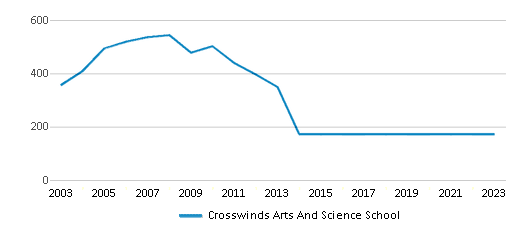
Total Classroom Teachers
14 teachers
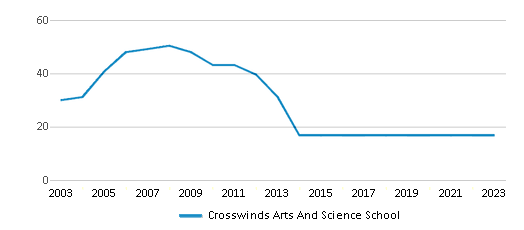
Students by Grade
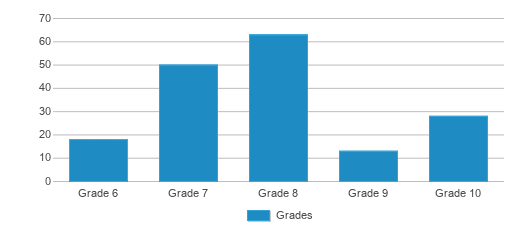
School Rankings
Math Test Scores (% Proficient)
(13-14)25-29%
61%
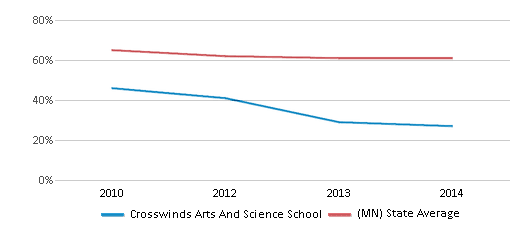
Reading/Language Arts Test Scores (% Proficient)
(13-14)50-54%
59%
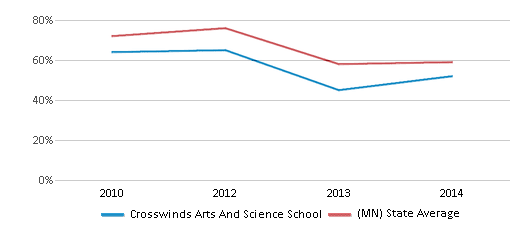
Student : Teacher Ratio
12:1
13:1
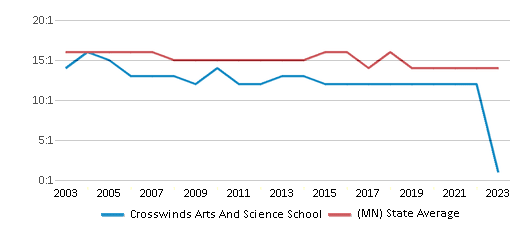
American Indian
3%
2%
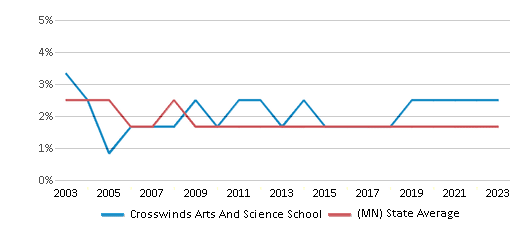
Asian
11%
7%

Hispanic
23%
12%
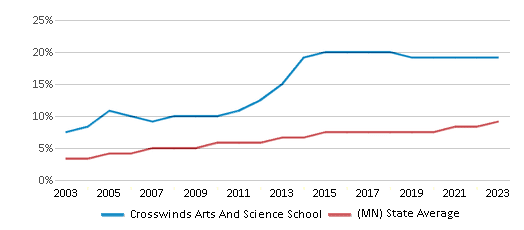
Black
19%
12%
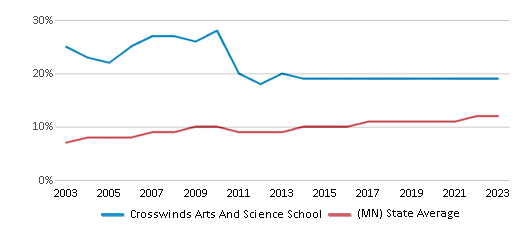
White
42%
61%
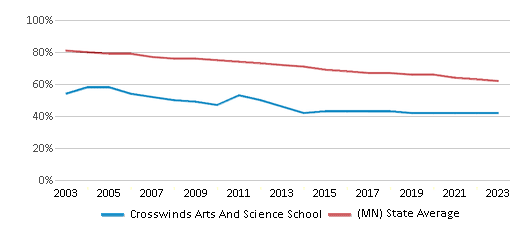
Hawaiian
n/a
n/a
Two or more races
2%
6%
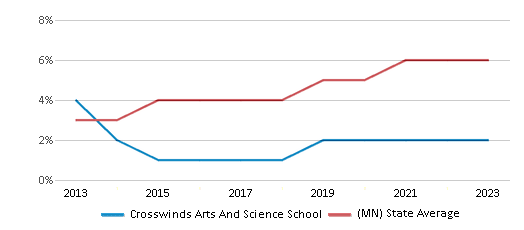
All Ethnic Groups
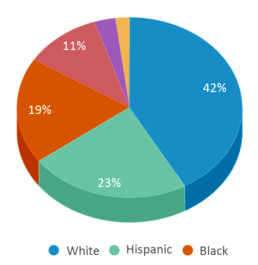
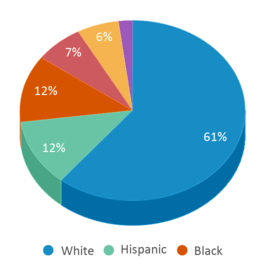
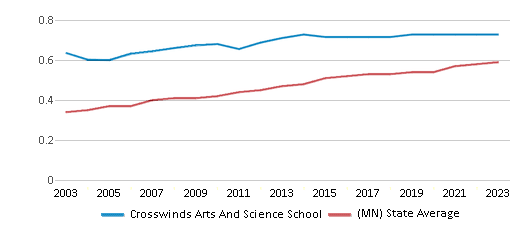
Eligible for Free Lunch
48%
36%
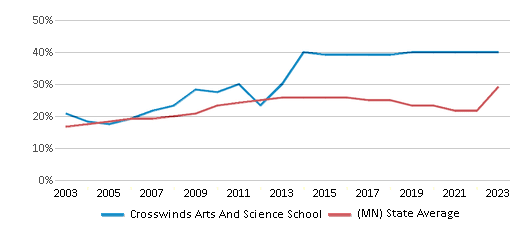
Eligible for Reduced Lunch
10%
7%
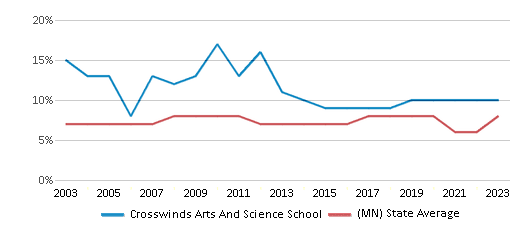
School Statewide Testing
School District Name
Equity Alliance Minnesota School District
Source: National Center for Education Statistics (NCES), MN Dept. of Education
School Notes
- Crosswinds has served the East Metro since 2000 and is beginning a new chapter in its story with its management by the Perpich Center for Arts Education. We have always been an arts and science magnet school, and Perpich brings an energetic, research-based focus to those activities at Crosswinds. We also serve as a vital inter-district integration magnet school in the East Metro, creating a student body that reaches beyond simple diversity to develop friendships and a true respect for various cultures among our students.
Frequently Asked Questions
What percent of students have achieved state testing proficiency in math and reading?
25-29% of students have achieved math proficiency (compared to the 61% MN state average), while 50-54% of students have achieved reading proficiency (compared to the 59% MN state average).
How many students attend Crosswinds Arts And Science School?
172 students attend Crosswinds Arts And Science School.
What is the racial composition of the student body?
42% of Crosswinds Arts And Science School students are White, 23% of students are Hispanic, 19% of students are Black, 11% of students are Asian, 3% of students are American Indian, and 2% of students are Two or more races.
What is the student:teacher ratio of Crosswinds Arts And Science School?
Crosswinds Arts And Science School has a student ration of 12:1, which is lower than the Minnesota state average of 13:1.
What grades does Crosswinds Arts And Science School offer ?
Crosswinds Arts And Science School offers enrollment in grades 6-10
What school district is Crosswinds Arts And Science School part of?
Crosswinds Arts And Science School is part of Equity Alliance Minnesota School District.
Recent Articles

What Is A Charter School?
Explore the world of charter schools in this comprehensive guide. Learn about their history, how they operate, and the pros and cons of this educational innovation. Discover key facts about charter schools, including admission policies, demographics, and funding, as well as what to look for when considering a charter school for your child.

10 Reasons Why High School Sports Benefit Students
Discover the 10 compelling reasons why high school sports are beneficial for students. This comprehensive article explores how athletics enhance academic performance, foster personal growth, and develop crucial life skills. From improved fitness and time management to leadership development and community representation, learn why participating in high school sports can be a game-changer for students' overall success and well-being.

February 05, 2025
Understanding the U.S. Department of Education: Structure, Impact, and EvolutionWe explore how the Department of Education shapes American education, from its cabinet-level leadership to its impact on millions of students, written for general audiences seeking clarity on this vital institution.





